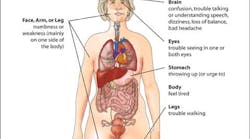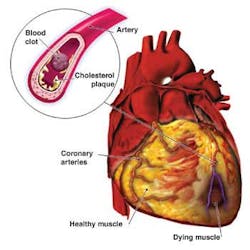The American Heart Association (AHA) has issued a new update on heart disease and stroke. Some of the highlights include:
• Rates of death attributable to cardiovascular disease (CVD) have declined, yet the burden of disease remains high. Based on 2009 data:
o The overall rate of death attributable to CVD was 236.1 per 100,000
o More than 2,150 Americans die of CVD each day, an average of 1 death every 40 seconds
o Stroke accounted for ≈1 of every 19 deaths in the United States
• Prevalence and control of traditional risk factors remains an issue for many Americans:
o 33.0% of U.S. adults have hypertension. That's 78 million adults.
o An estimated 31.9 million adults have total serum cholesterol levels ≥240 mg/dL
o An estimated 19.7 million Americans had diagnosed diabetes mellitus, representing 8.3% of the adult population
• Expanded data coverage of the obesity epidemic:
o The estimated prevalence of overweight and obesity in U.S. adults is 154.7 million
o Among children (2 to 19 years of age), 23.9 million are overweight or obese and 12.7 million are obese
• The 2013 Statistical Update(1) includes critical data about cardiovascular health, health factors, health behaviors and other risk factors, cardiovascular conditions and diseases, cardiovascular quality of care, procedure utilization, and costs.
“The American Academy of Periodontology (AAP), in collaboration with the European Federation of Periodontology (EFP), recently published a series of consensus reports that analyze the scientific evidence linking periodontal disease, specifically periodontitis, to other systemic diseases, including diabetes, cardiovascular disease and adverse pregnancy outcomes. The consensus reports, which appear in both the Journal of Periodontology and the Journal of Clinical Periodontology, also outline clinical recommendations for dental professionals to use when treating patients at risk for, or presenting with, certain medical conditions.”(2)
“Specifically, the consensus reports conclude:
• There is strong epidemiologic evidence that periodontitis provides an increased risk for future cardiovascular disease. Dental professionals should discuss other risk factors for cardiovascular disease with their patients, including hypertension, obesity, and tobacco use. The treatment of periodontitis in patients with a history of cardiovascular disease should follow the American Heart Association guidelines for elective procedures.
• There is an independent association between moderate to severe periodontitis and an increased risk for the development or progression of diabetes. Periodontal interventions may provide beneficial effects on diabetes outcomes in some patients, so regular comprehensive periodontal evaluations should be part of an ongoing diabetes management program.
• While some studies suggest a modest association between maternal periodontitis and adverse pregnancy outcomes, there is currently insufficient evidence that periodontal therapy can be recommended as a means to improve pregnancy outcomes. Periodontal therapy is considered safe in pregnant women and can result in improved periodontal health, but dental professionals are urged to adhere to general obstetric guidelines that suggest elective procedures should be avoided in the first trimester.
• Evidence suggests a relationship between periodontitis and other systemic diseases, including chronic obstructive pulmonary disease, pneumonia, chronic kidney disease, rheumatoid arthritis, cognitive impairment, obesity, metabolic syndrome and cancer. However, additional studies are needed to better understand these associations.
The consensus reports also identified recommendations for future research, such as well-designed interventional studies and randomized clinical trials, to enhance understanding of the impact of periodontitis and periodontal treatment on overall health. The complete consensus reports are freely available online.
The consensus reports were developed at a joint workshop held in Segovia, Spain, in November 2012. More than 70 international experts met to conduct an intense review of the available evidence supporting the association between periodontitis and other systemic diseases.”(2)
See the full report at no cost online.(3)
References
1. Go AS, Mozaffarian D, Roger VL, Benjamin EJ, Berry JD, Borden WB, Bravata DM, Dai S, Ford ES, Fox CS, Franco S, Fullerton HJ, Gillespie C, Hailpern SM, Heit JA, Howard VJ, Huffman MD, Kissela BM, Kittner SJ, Lackland DT, Lichtman JH, Lisabeth LD, Magid D, Marcus GM, Marelli A, Matchar DB, McGuire DK, Mohler ER, Moy CS, Mussolino ME, Nichol G, Paynter NP, Schreiner PJ, Sorlie PD, Stein J, Turan TN, Virani SS, Wong ND, Woo D, Turner MB; on behalf of the American Heart Association Statistics Committee and Stroke Statistics Subcommittee. Heart disease and stroke statistics—2013 update: a report from the American Heart Association. Circulation. 2013;127:e6-e245. http://circ.ahajournals.org/content/127/1/e6.
2. http://www.perio.org/perio.org/consumer/EFP_AAP_Workshop_Proceedings.
3. Special issue: Periodontitis and Systemic Diseases - Proceedings of a workshop jointly held by the European Federation of Periodontology and American Academy of Periodontology. Co-edited by Maurizio Tonetti and Kenneth S. Kornman. The workshop was funded by an unrestricted educational grant from Colgate-Palmolive to the European Federation of Periodontology and the American Academy of Periodontology. All manuscripts were fully peer reviewed. Journal of Periodontology, Volume: 84, Number: 4-s April 2013. http://www.joponline.org/toc/jop/84/4-s.









